The Specialists
When does a passion for a particular duck become an obsession? Four fanatical waterfowlers share their stories and species-specific strategies.
When does a passion for a particular duck become an obsession? Four fanatical waterfowlers share their stories and species-specific strategies.
The mallard, the American black duck, the northern pintail, and the canvasback hold special places in the hearts of waterfowlers. These remarkable birds can be prizes for any of us, but for a few avid hunters, they are much more. For them, the pursuit of one of these species has become a singular focus and goal, a specific reason for rising early and braving the elements, a unique challenge and a special rewardin short, an obsession. For these duck zealots, this one species has come to represent what they love most about waterfowling.
These are the specialists. They are lifelong students of their chosen quarry's habits and behaviors.
They spend countless hours scheming and planning and discussing ways to bring more of these birds to the bag, and their years of hunting experience have endowed them with expert knowledge about the specific gear and unique tactics required to successfully target a single species. Here, four specialists from across the country share their passion and reveal their secrets. Try their strategies this season. You just might become a specialist too.
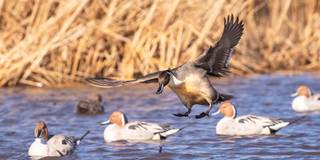
A mixed decoy spread looks natural, but make sure to separate your decoys by species.
Photo DOUGSTEINKE.COM
Dennis Campini shot his first ducka bull sprigin the 1970s, kicking off a lifelong infatuation with pintails. "They are majestic, wary, and great table fare, and they are a symbol of the Central Valley's Grasslands," he says. "I serve as president of the Grassland Resource Conservation District, and the pintail is on our logo."
A member of the 100-year-old Stillbow Ranch Duck Club his entire adult life, Campini says the pintail limit when he started hunting was seven ducks plus bonus pintails. Over time, he has watched the limit drop to one bird. Yet pintails still flock to the area, and Campini still prefers the pintail over all others. He is passing on his love of pintails and duck hunting to his young son, Logan, who frequently joins him in the blind.
There's very little rice grown in this part of the Central Valley. Instead, pintails feed on native seed-bearing wetland plants like swamp timothy. The Stillbow Club has worked hard to make the place attractive to pintails. "We graded an area of about 200 acres that's open and shallow, with no tules around it. We flood it early and it attracts pintails beginning in August. We hardly ever shoot pintails back in our woods blinds. They like the bigger water," Campini says.
Early in the season, pintails move up and down the valley, going where the food is. They will visit the northern Grasslands and make the 100-mile journey north to the rice fields of the Stockton Delta, often returning to the southern Grasslands in December and January.
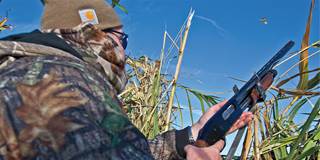
Pintails are cagey and more cautious than many other ducks, especially later in the season. Keep your blinds maintained and well brushed.
Photo DOUGSTEINKE.COM
Campini says pintails are always wary, but those late-season birds prove especially tough. "You have to hide very well," he explains. "Our big-water area has pit blinds, and late in the year the ground around them has been trampled down by dogs and hunters. The hunters who are successful bring in more grass to hide the pits. We'll also use camo netting to soften the outlines of the holes in the pits and sometimes to hide dogs."
Due to the mix of ducks at Stillbow, Campini's decoy spreads consist of multiple species that are separated by type. "I believe pintails like pintail decoys, and they will often come to the pintails in the spread," he says. A typical rig consists of a dozen mallards, two or three dozen pintails, two dozen canvasbacks, and a few dozen wigeon and teal. Although the canvasback decoys are there to attract the cans that frequent the club's open water, Campini believes the white on those decoys also improves the spread's visibility.
Pintails react well to a call, and many of the club's members use the Matt Pierce Game Calls whistle, made by the club's caretaker. The whistle slides open like a trombone, allowing the user to make high- and low-pitched pintail trills. The whistle can also be used to make wigeon, teal, and drake mallard calls.
"We'll blow a series of whistles to get their attention, then tone our calling down when they start to work," Campini says. "I like to mix in some mallard drake grunts and wigeon whistles too. Sometimes you'll see pintails flying with other ducks, like wigeon. In that case, we'll call to the wigeon, and they will bring the pintails with them."
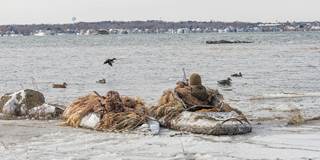
Photo BILLBUCKLEYPHOTOGRAPHY.COM
"My favorite kind of day to hunt black ducks is during a nor'easter with ice and a nasty wind that blows the snow sideways," says Hank Garvey, who hunts around Plum Island, Massachusetts. "They finish really well on days like that."
Garvey loves these iconic birds. Because the limit most years is just one or two black ducks, and because the hunting is often difficult, you have to love them, he says. "Hunting the tidal creeks is a lot of work for one or two ducks, but black ducks are the wariest duckswarier than mallards and pintailsand the area I hunt is rich in history. Market hunters shot black ducks on what is now the Parker River National Wildlife Refuge."
Garvey hunts from a scull boat some days, and he goes "creeking" (jump-shooting) in the marshes on others. But he prefers hunting over his own hand-carved decoys from the Barnegat Bay sneakbox he built himself. "Hunting over my own decoys out of my own boat lets me step back in time," he says, "and the ducks work in close."
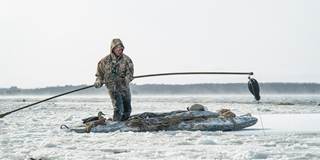
Photo BILLBUCKLEYPHOTOGRAPHY.COM
With black ducks, as with all ducks, scouting is important. "Even after hunting this area for 30 years, I still try to spend one day scouting for every day I spend hunting," Garvey says. "I can see what they do on different days at different tides and weather conditions. Last year I took a day to scout and saw birds dropping into a spot I had never seen them use before, and I had a good walk-in hunt the next day."
The tidal nature of black duck hunting means early morning isn't necessarily the time to go. Instead, you plan your hunt around the high tide, which can occur any time of day. A rising tide brings the ducks in to the salt pans (ponds) and creeks, where they can find seeds. At most, Garvey will use a dozen decoys in the creeks, which are only about 20 yards across. The low-profile, low-draft sneakbox tucks in perfectly against the banks of the guzzlers and mosquito ditches (tributary creeks), which are often just four or five feet wide. As the tide comes up, he has to move his boat and rig every 30 minutes or so. He says you have to know what you're doing, or you might find yourself stranded for several hours when the tide goes out.
"The best hunting on the creeks comes late in the season, when the weather turns cold. That's the game changer, because the salt pans freeze and the ducks can't sit on them all day," Garvey says. "I'll cut my spread down to as few as five decoys, both because the ducks are wary and because if an ice floe comes down the creek and sweeps my decoys away I don't have as many to chase."
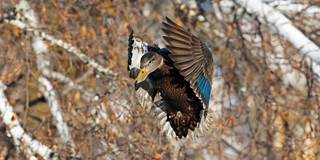
Photo MICHAELFURTMAN.COM
Although black ducks don't need to see a lot of decoys, Garvey, an award-winning decoy carver, sets out decoys in a variety of poses and believes that makes a difference. In keeping with his light decoy footprint, he doesn't call much either, instead gently coaxing the birds in and letting his decoys do the job of bringing them close for a good shot.

When mallards are being evasive, try switching locations, altering your spread, or modifying your calling.
Photo DOUGSTEINKE.COM
Travis Mueller, national sales manager for Banded, hunts mallards on a public reservoir near his eastern Iowa home. "Mallard hunting is like turkey hunting. It's a chess game. Mallards fly higher, look harder, and have more second thoughts than other ducks, especially on public land," he says. "Hunting public-land mallards takes a lot of time and energy, and the older I get the harder it is, but it's rewarding when it works.
"Scouting isn't just a part of successful mallard hunting," Mueller continues. "It's the most important part. You have to be where the ducks want to go, and mallards can go anywhere, from fields to marshes to timber to rivers to ponds. Mallard hunting is 80 percent scouting, 10 percent gear, and 10 percent luck."
Mueller scouts a large area, glassing and watching for ducks to drop in. "That's where luck comes in," he says. "If it's sunny out, you have to be looking right at ducks to see them. Cloudy days make me nervous because ducks are easier to see and I'm afraid other hunters might spot them too." At sunset he will often park, shut off his truck, and listen. "You can hear the ducks on the water from a long way away, and I have hunted the area enough to know where they must be sitting," he says.
Hunting public water successfully means not getting into a rut. "Most hunters are creatures of habit," Mueller says. "They go to the same place and do the same thing. We try to vary our spread. A couple years ago we took three boats full of decoys and set out 500 blocks. Some days we only use two dozen. Some days we put out spinners. Some days we don't. Lately, we have been using goose decoys because I see more geese using the reservoir, and ducks seem to feel safe with them. It's trial and error. I can't tell you what works, but I can say that you have to change it up."
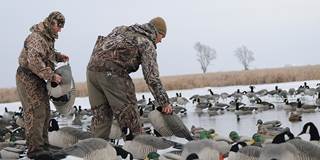
In certain scenarios, adding goose decoys to your spread can help bring more greenheads within range.
Photo JIM THOMPSON
The same holds true for calling. "Some days you can't blow a note at them, and some days you have to stay on them all the way to the water," Mueller explains. "I think those days are the ones when there is so much calling going on that they can get pulled away from you if you stop."
The one constant is concealment. "You can't be successful on public land if you're not well hidden," Mueller says. "If it's sunny, the shadows help, but on cloudy days you'd better bring your clippers and cover your boat and your hiding spot really well."
Finally, success for mallards on public land means keeping up with pressured ducks while staying ahead of other hunters. "If we get a couple of days out of a spot, we're happy," Mueller says. "We try to get our birds and get out so we might have a chance the next day. A lot of people will shoot limits and then start calling their buddies. But if ducks get shot at in a particular place, they'll usually stop going there. If you want to be successful on public land, your circle of friends has to shrink during duck season."
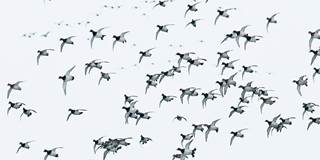
Submerged beds of wild celery attract large gatherings of cans each fall.
Photo DAVIDSTIMAC.COM
Ask Lee Kjos what he likes about canvasbacks and he'll answer: "Everything. I love how they fly and how they look when they raft up. The red of their head is my favorite color. I love the way they look, with their bull necks, and I love how they decoy, and I love the fighter-jet sound of a flock passing over the decoys. I don't think they taste any better than a grain-fed mallard, but cans are the most fun to hunt."
Based in southern Minnesota, Kjos is a professional photographer who grew up as the son of a dedicated diver hunter. He followed in his father's footsteps, hunting Minnesota's big diver lakesLeech, Bowstring, and Winnibigoshishwhere canvasbacks come every year to feed on wild celery.
"Cans are calendar birds. They do the same thing at the same time every year," Kjos says. "They are vulnerable in the fall because they are slaves to their food. You find them in the wild celery beds, diving for the bulbs. You can shoot a few cans in other places, but if you want the thrill of 200 birds in the decoys, you need to be on a big lake in the wild celery."
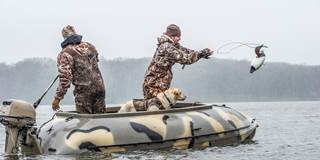
Photo Lee Thomas Kjos/THERAWSPIRIT.C
Kjos likes a clear morning with a strong wind to keep the ducks moving, but not so strong that it's unsafe to hunt. His decoy rig consists of 85 hand-carved canvasback decoys, including a few antique collectibles from carvers like Duncan Ducharme. "If you want to shoot cans, you need canvasback decoys," Kjos explains. "I have never seen a duck that likes their own kind more. I grew up reading about the traditions of canvasback hunting and the market hunting era, so maybe that's why I'd rather have 85 wooden decoys than 300 plastic ones. I also believe the old-style round-bottom wooden decoys sit lower and roll more realistically than modern decoys do."
In large areas of open water, Kjos will rig decoys on long lines. "The cans will run the string just like any divers," he says. "One pass is usually enough, then they commit." He prefers to hunt closer to shore, in the wild celery beds, and there he'll dispense with long lines and rig his decoys on eight-foot lines, setting them in a random pattern 25 yards from the boat. Neither concealment nor calling are especially important. "In open water they'll sometimes take a rip right over the boat," Kjos says. "I've pulled the boat up on a point, too, brushed it a little, and never had a problem. I have a diver call but I never use it. Cans are a more forgiving duck than a mallard, but when they do the deal up close, full speed with those big paddles out, there's nothing else like it."
Ducks Unlimited uses cookies to enhance your browsing experience, optimize site functionality, analyze traffic, and deliver personalized advertising through third parties. By continuing to use this site, you agree to our use of cookies. View Privacy Policy